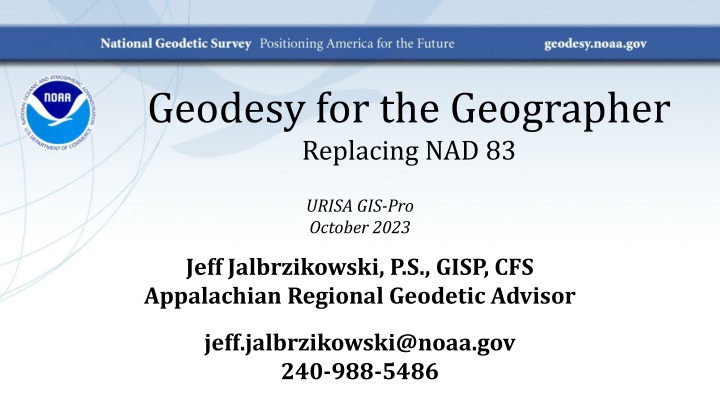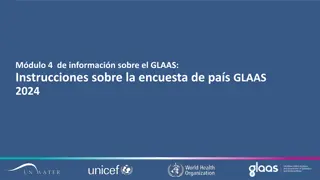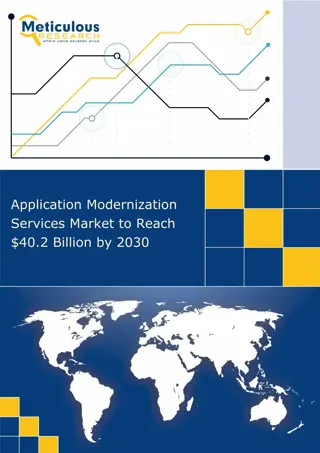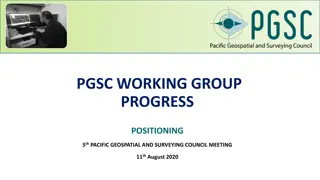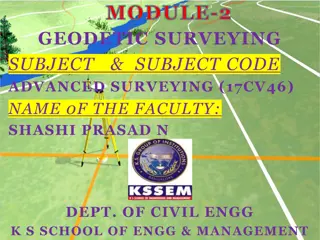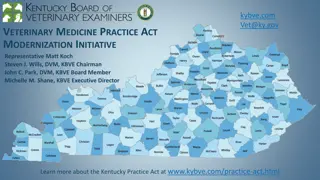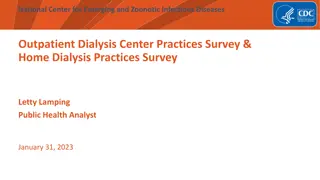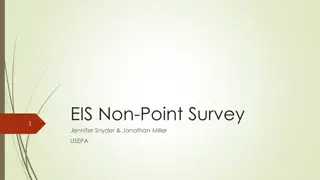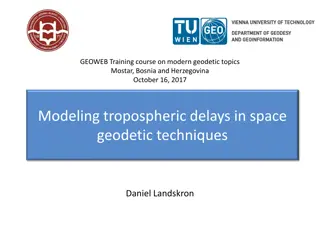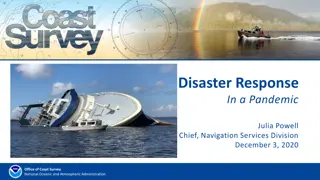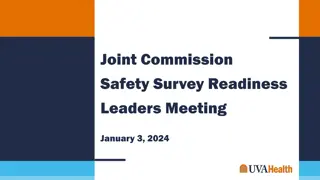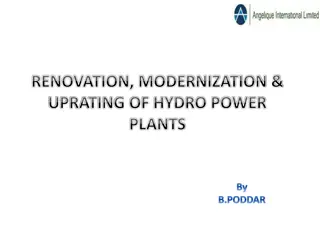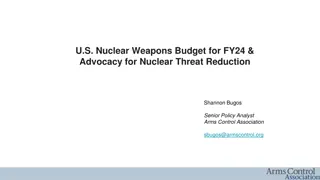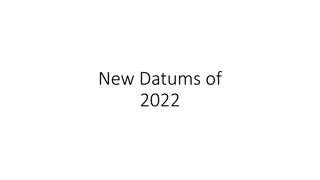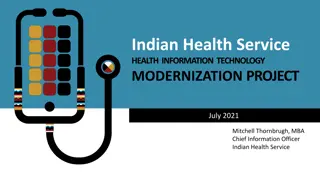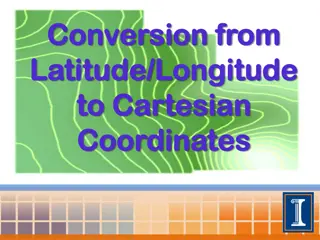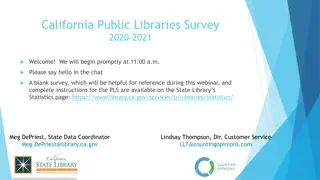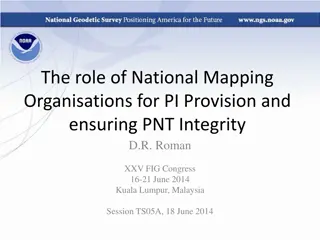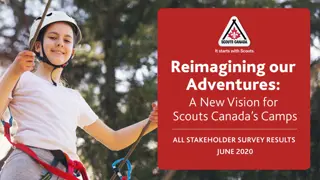National Geodetic Survey Modernization Overview
The National Geodetic Survey (NGS) is modernizing the National Spatial Reference System (NSRS) to enhance accuracy, accessibility, and efficiency. This involves updating coordinates, replacing datums, simplifying services, and ensuring compatibility with time changes. The goal is to provide a reliable geospatial framework to address the nation's economic, social, and environmental needs by 2025.
Download Presentation

Please find below an Image/Link to download the presentation.
The content on the website is provided AS IS for your information and personal use only. It may not be sold, licensed, or shared on other websites without obtaining consent from the author.If you encounter any issues during the download, it is possible that the publisher has removed the file from their server.
You are allowed to download the files provided on this website for personal or commercial use, subject to the condition that they are used lawfully. All files are the property of their respective owners.
The content on the website is provided AS IS for your information and personal use only. It may not be sold, licensed, or shared on other websites without obtaining consent from the author.
E N D
Presentation Transcript
Geodesy for the Geographer Replacing NAD 83 URISA GIS-Pro October 2023 Jeff Jalbrzikowski, P.S., GISP, CFS Appalachian Regional Geodetic Advisor jeff.jalbrzikowski@noaa.gov 240-988-5486
Organizational Structure -Department of Commerce (DoC) (~47,000 employees) -National Oceanic and Atmospheric Administration (NOAA) -National Ocean Service (NOS) -National Geodetic Survey (NGS) (~175 employees)
Organizational Structure -Department of Commerce (DoC) (~47,000 employees) -National Oceanic and Atmospheric Administration (NOAA) -National Ocean Service (NOS) -National Geodetic Survey (NGS) (~175 employees)
NGS Mission To define, maintain and provide access to the National Spatial Reference System (NSRS) to meet our Nation s economic, social, and environmental needs. NSRS
Modernizing the NSRS Updating all NSRS coordinates Replace existing datums with new datums Replacing existing SPCS83 with new SPCS2022 Accounting for coordinates changing with time Improving NGS products and services Simplifying customer contributions Making the NSRS: More accurate More accessible More efficient Rollout in 2025
NSRS Modernization What s going to stay the same? What s going to be different?
National Spatial Reference System A common and consistent geospatial framework to meet the economic, social, and environmental positioning needs of our Nation. Foundational elements include: Latitude Horizontal Datums Datums Datums Datums Longitude Height Gravity Shoreline Position Horizontal Vertical Vertical Elevation NAD83 NAD27 NAVD88 NGVD29 Great Lakes Great Lakes Datums Datums Geoid Models Models Geoid how these change over time IGLD85 IGLD55 GEOID18 GEOID12B
Positional Components of the NSRS Geometric aka Horizontal Latitude, Longitude, Ellipsoid Height NAD83 Geopotential aka Orthometric Height aka Elevation NAVD88
North American Datum of 1983 NAD83 will be replaced by
North American Terrestrial Reference Frame of 2022 NATRF2022 (pronounced: nat-ref)
Terrestrial Reference Frame? Existing, accepted terminology International TRF first realization of the ITRF was 1992 NATRF2022 will be based on ITRF2020 Horizontal Datum misnomer for NAD83
ITRF concept Watch the grid! Drift Epoch:
NATRF2022 North American Terrestrial Reference Frame of 2022 will replace NAD83 North American Datum of 1983 Technically, not just NATRF2022 but also its 4 sister TRFs
Four TRFs for Modernized NSRS North American Terrestrial Reference Frame of 2022 (NATRF2022) Pacific Terrestrial Reference Frame of 2022 (PATRF2022) Caribbean Terrestrial Reference Frame of 2022 (CATRF2022) Mariana Terrestrial Reference Frame of 2022 (MATRF2022)
Plate-Fixed NSRS TRFs ITRF NATRF Frame = constant NA Plate = rotating Frame = rotating (relative to ITRF) NA Plate = constant (relative to NATRF2022)
NATRF rotating frame, constant with plate Plate-Fixed
if you know epoch ITRF or NATRF your choice if you know epoch
Terminology - Changing Coordinates Conversion change the type of coordinate NAD83(2011) latitude & longitude NAD83(2011) SPCS Transformation change the datum of coordinate NGVD29height NAVD88height NAD 27 latitude & longitude NAD 83(2011) latitude & longitude Propagation change the epoch of coordinate NATRF2022 epoch 2020.00 to NATRF2022 epoch 2023.243
Estimated Geometric Change - Horizontal NAD83 (2011) NATRF2022 4.6 ft ft 4.6 4.3 ft ft 3.9 ft ft 4.3 3.9 3.6 ft ft 3.6 3.0 ft ft 3.0
Remember What s the goal of NATRF2022? Give you the stability in positions that you expect That s the point of Reference Epochs (REs) Akin to the different realizations of NAD83 aka versions REs will be published every 5 or 10 years you choose when you update we expect many users will adopt our first Reference Epoch Coordinates (RECs), then stay there long term
Preparing for New Datums Two factors will dictate your frequency of coordinate updates 1) Your accuracy needs 2) The region you work in tectonic motion Do manholes need cm-level updates annually? We accommodate that you choose Just because we re chasing the millimeter it doesn t mean you need to.
Preparing for New Datums Know the epoch of your data/datasets consider how you will track this full to-the-second timestamp on every feature? labeling a year for each dataset? something in-between that works for your needs?
Preparing for New Datums Reprocessing your data in a perfect world, everyone would reprocess What does this really mean? consider a hydro-enforced DEM start over with the raw flight data (GNSS/IMU) generate new point clouds recreate all the drainage features in new datum Unrealistic for vast majority
Preparing for New Datums Transforming your data NGS Coordinate Conversion and Transformation Tool ASCII up/download, Web Services, or Download Source code on GitHub github.com/noaa-ngs ask your software provider(s) about integration we envision COTS integrations as most popular method of access
NCAT will allow you to propagate new field data from Survey Epoch to Reference Epoch
About the timing of it all Timeline Complete review of stakeholder submittals Late 2022-Early 2023: Preliminary designs for stakeholder review Mid-2023: Finalize all zone designs Other things in 2023 Provide machine-readable definitions Modify NGS algorithms (e.g., 1-parallel Lambert) Document new projection algorithms Release with rollout of modernized NSRS Final definitions available by late 2023 Release with new datums in 2025 Rollout in 2025 29
geodesy.noaa.gov/ADVISORS/ Regional Geodetic Advisor Program 14 RGAs across country We are here to support: You Your constituents Our Federal Partners Questions about NSRS Modernization? Reach out now Be prepared
Jeff Jalbrzikowski, P.S., GISP, CFS Appalachian Regional Geodetic Advisor jeff.jalbrzikowski@noaa.gov 240-988-5486 https://www.ngs.noaa.gov/ADVISORS/ https://www.ngs.noaa.gov/ADVISORS/ use any major search engine: NGS advisors
